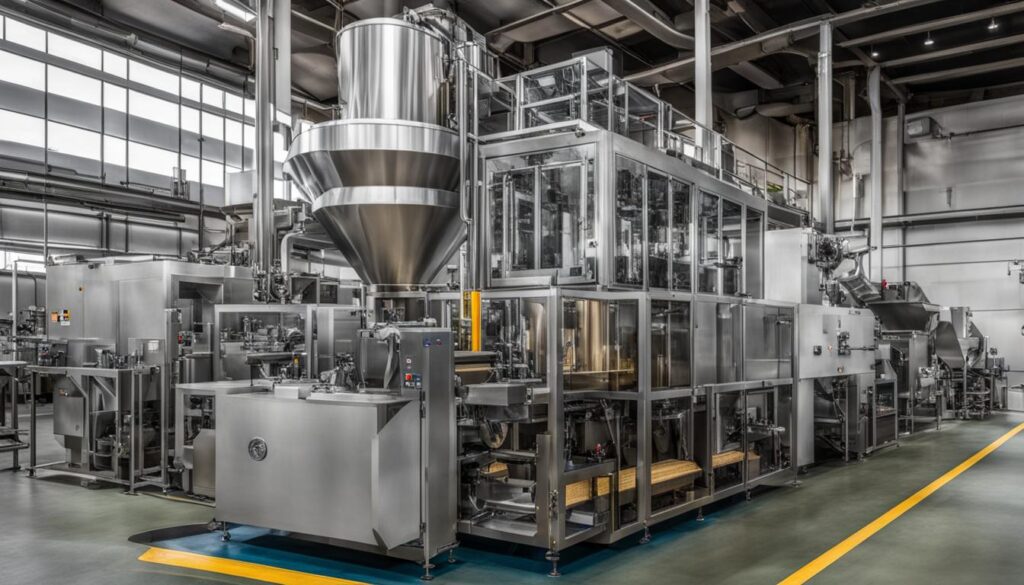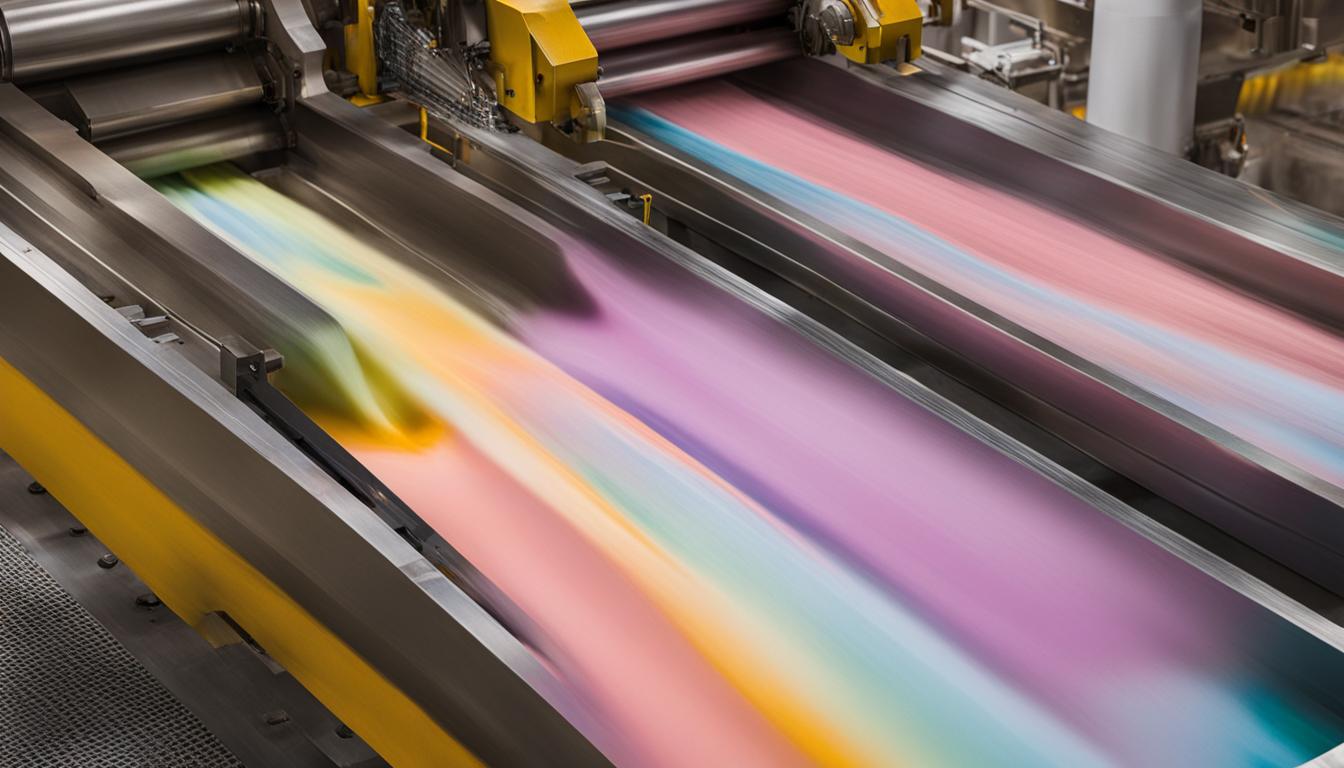Have you ever wondered about the origins of chewing gum? Or how it’s made? Chewing gum has a fascinating history that stretches back thousands of years, with ancient civilizations incorporating it into their traditions and practices.
But what exactly goes into making this popular confectionery? Is it a complex process involving natural substances or a modern creation made from synthetic ingredients?
In this article, we will delve into the rich history of chewing gum and explore the step-by-step manufacturing process behind this beloved treat. Prepare to uncover surprising facts and challenge common beliefs as we unravel the secrets of chewing gum production.
Key Takeaways:
- Chewing gum has a long history, dating back thousands of years.
- The manufacturing process involves mixing ingredients in a sigma mixer, extruding the gum, cooling, cutting, and packaging.
- Gum base, the main ingredient, is made from a combination of resin, wax, and elastomers derived from petrochemicals.
- Additional ingredients such as sweeteners, flavors, emulsifiers, antioxidants, and humectants are added to enhance the taste and texture of the gum.
- Contrary to popular belief, most modern chewing gum is made from synthetic ingredients rather than natural substances.
The Origins of Chewing Gum
Chewing gum has been enjoyed and appreciated by civilizations throughout history, each with their unique forms and ingredients.
In northern Europe, people indulged in the pleasure and beneficial effects of chewing birch bark tar. This sticky substance was not only used for enjoyment but also had medicinal purposes.
The Mayans and Aztecs found their solution to quenching thirst and fighting hunger in chicle, a natural tree gum extracted from the sapodilla tree. They would chew on chicle to satisfy their cravings while on long journeys.
In ancient Greece, mastic gum was widely used for chewing. Derived from the resin of the mastic tree, this gum was not only chewed for enjoyment but also for its believed medicinal properties.
The indigenous people of North America discovered the benefits of chewing spruce tree resin. They chewed on the resin to alleviate thirst and hunger, a practice that was later adopted by European settlers.
The commercial production of chewing gum began in the United States in the 1840s. John Curtis played a pivotal role in this industry by creating spruce gum, which gained popularity as a confectionery product.
However, it was Thomas Adams who revolutionized the gum industry with the discovery of chicle. Obtained from the exiled Mexican president, General Antonio López de Santa Anna, Adams utilized chicle to develop the first commercial chewing gum in the late 1800s.
Chicle remained the primary ingredient in gum production until synthetic alternatives became prevalent in the mid-1900s. This shift allowed gum manufacturers to explore new flavors and textures, catering to the evolving preferences of consumers.
Chewing gum quickly gained popularity in the United States, thanks to intense advertising campaigns by companies like Wrigley. Brands such as Juicy Fruit and Wrigley’s Spearmint became iconic symbols of gum chewing.
The early 20th century witnessed another significant development in the gum industry with the creation of bubble gum. Walter Diemer successfully formulated the first commercial bubble gum, known as Dubble Bubble, which introduced a whole new dimension of enjoyment and entertainment to gum chewing.
The Manufacturing Process of Chewing Gum
The manufacturing process of chewing gum involves several steps that transform a combination of ingredients into the familiar and enjoyable confectionery we know. Let’s take a closer look at how chewing gum is made.
Firstly, the ingredients used in gum production are mixed together in a specialized machine called a sigma mixer. These ingredients include gum base, sweeteners, softeners, flavors, colors, and polyols. The gum base is the key component and is made up of resin, wax, and elastomers, which provide the chewiness, softness, and elasticity of the gum.
Once the ingredients are thoroughly mixed, the gum base is kneaded until it reaches the consistency of bread dough. This kneading process ensures that the gum base is properly blended and ready for the next stage.
Next, the gum base is extruded from the mixer, forming long sheets or small blocks. These sheets or blocks are then cooled to solidify the gum and make it easier to handle during the cutting and packaging process.
After cooling, the gum is cut into the desired shape and size. Whether it’s stick-shaped, pellet-shaped, or any other form, the cutting process ensures uniformity and consistency across each piece of gum.
Lastly, the freshly cut gum is carefully packaged, ready for distribution and consumption.
But the manufacturing process doesn’t end there. To create the wide range of flavors, textures, and characteristics that consumers enjoy, additional ingredients such as flavors, sweeteners, emulsifiers, antioxidants, and humectants are added to the gum base. These ingredients enhance the taste, softness, freshness, and moisture of the gum, providing a satisfying chewing experience.
The use of various manufacturing techniques and ingredients allows gum manufacturers to create different types of gum that cater to diverse consumer preferences.
Here’s an overview of the manufacturing process of chewing gum:
| Step | Description |
|---|---|
| Mixing | Ingredients, including gum base, sweeteners, softeners, flavors, colors, and polyols, are mixed in a sigma mixer. |
| Kneading | The gum base is kneaded until it reaches the consistency of bread dough. |
| Extrusion | The gum base is extruded from the mixer, forming sheets or blocks. |
| Cooling | The gum is cooled to solidify it before the cutting process. |
| Cutting | The cooled gum is cut into the desired shape and size. |
| Packaging | The freshly cut gum is packaged for distribution and consumption. |

The Evolution of Chewing Gum
Chewing gum has undergone a remarkable evolution over time, with significant advancements in both ingredients and flavors. In the early days, chewing gum was made from natural resins and waxes extracted from trees like spruce, mastic, and chicle. These gums had limited flavor options and were primarily used for their masticatory properties and oral health benefits. However, with the introduction of synthetic ingredients, the range of flavors and textures in chewing gum expanded dramatically.
Today, chewing gum comes in a wide variety of shapes, sizes, and flavors, catering to diverse consumer preferences and tastes. From traditional mint and fruit flavors to more unique options like bubblegum, cinnamon, and soda, the choices are practically endless. Gum manufacturers are constantly innovating to introduce new and exciting flavors, textures, and functional benefits to keep up with the evolving market trends.
During the early 20th century, bubble gum added a whole new dimension to the gum industry. With its ability to stretch and blow bubbles, bubble gum quickly became a favorite among consumers, providing them with a fun and prolonged chewing experience.
Beyond flavor and texture, gum manufacturers consider various factors to meet changing consumer demands. Today’s chewing gum industry takes into account factors like sugar-free options, dental health, natural ingredients, novelty packaging, and functional benefits such as breath freshening, teeth whitening, or even stress relief.
“The evolution of chewing gum showcases the industry’s commitment to meeting consumer preferences and staying relevant in a competitive market. We strive to continuously adapt and introduce new flavors, textures, and functional benefits, ensuring that gum remains a popular confectionery enjoyed by people of all ages.”
Evolution of Chewing Gum Flavors
| Time Period | Traditional Flavors | Innovative Flavors |
|---|---|---|
| Early Days | Mint, Fruit | N/A |
| 20th Century | Bubblegum, Cinnamon | Spearmint, Wintergreen |
| Modern Era | Peppermint, Fruit punch | Watermelon, Strawberry Cheesecake, Blueberry Acai |
As highlighted in the table above, the evolution of chewing gum flavors has been staggering. From the early days with limited flavor options to the modern era with an extensive range of choices, chewing gum continues to captivate consumers with its delightful variety.
The Process of Making Chewing Gum
The process of making chewing gum involves both science and art. Manufacturers carefully select and blend the right combination of ingredients to achieve the desired taste, texture, and appearance of the final product.
The use of natural and synthetic flavors, along with various sweeteners and colors, allows for a wide range of gum varieties. Flavor release is an important aspect of gum production, with the goal of creating waves of flavor as the gum is chewed.
Different flavor particles or crystals may be used to enhance the perception of taste. The addition of sweeteners, both natural and artificial, provides the initial sweetness and prolongs the flavor experience.
Gum bases with higher proportions of elastomers are used in bubble gums to facilitate bubble-blowing. The manufacturing process is constantly refined and optimized to meet consumer expectations and preferences.
The quality and consistency of gum production are critical to ensure a satisfying chewing experience for consumers.
Conclusion
Chewing gum has a rich gum manufacturing history that stretches back to ancient civilizations and has continued to evolve through modern manufacturing processes. The commercialization of chewing gum began in the United States, where it gained popularity and sparked the introduction of iconic gum brands.
The manufacturing process of gum involves a series of steps, from mixing ingredients to packaging the final product. Gum bases, made from synthetic petrochemicals, play a crucial role in providing the desired chewiness, softness, and elasticity of gum. The inclusion of various flavors, sweeteners, and other ingredients enhances the taste and texture, making gum a satisfying confectionery.
Over time, the gum industry has adapted to changing consumer preferences, offering a wide range of flavors and varieties. Gum manufacturers continuously refine their techniques to meet market demands and innovate with new gum products. Despite the advancements in ingredients and manufacturing methods, chewing gum remains a timeless treat enjoyed by people of all ages.
